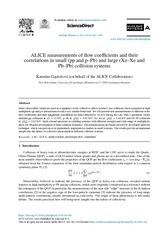ALICE measurements of flow coefficients and their correlations in small (pp and p–Pb) and large (Xe–Xe and Pb–Pb) collision systems
Gajdošová, Katarína; Acharya, Shreyasi; Acosta, Fernando T.; Adamová, Dagmar; Adolfsson, Jonatan; Aggarwal, Madan M.; Aglieri Rinella, Gianluca; Agnello, Michelangelo; Agrawal, Neelima; Ahammed, Zubayer; Alme, Johan; Altenkaemper, Lucas; Djuvsland, Øystein; Ersdal, Magnus Rentsch; Fionda, Fiorella Maria Celeste; Nystrand, Joakim; Rehman, Attiq Ur; Røhrich, Dieter; Tambave, Ganesh Jagannath; Ullaland, Kjetil; Wagner, Boris; Zhou, Zhuo; Arsene, Ionut Cristian; Bätzing, Paul Christoph; Dordic, Olja; Lardeux, Antoine Xavier; Lindal, Svein; Mahmood, Sohail Musa; Malik, Qasim Waheed; Richter, Matthias; Røed, Ketil; Skaali, Toralf Bernhard; Tveter, Trine Spedstad; Wikne, Jon Christopher; Zhao, Chengxin; Hetland, Kristin Fanebust; Kileng, Bjarte; Nesbø, Simon Voigt; Storetvedt, Maksim Melnik; Helstrup, Håvard; Langøy, Rune; Lien, Jørgen André; Ahn, Sang Un; Aiola, Salvatore; Akindinov, Alexander; Al-Turany, Mohammad; Alam, Sk Noor; Albuquerque, D. S. D.; Aleksandrov, Dmitry; Alessandro, Bruno; ALICE, Collaboration
Peer reviewed, Journal article
Published version

Åpne
Permanent lenke
https://hdl.handle.net/1956/22184Utgivelsesdato
2019Metadata
Vis full innførselSamlinger
Originalversjon
https://doi.org/10.1016/j.nuclphysa.2018.09.006Sammendrag
Many observables which are used as a signature of the collective effects in heavy-ion collisions when measured in high multiplicity pp and pA interactions reveal a very similar behaviour. We will present first measurements of different order flow coefficients and their magnitude correlations for data collected by ALICE during the LHC Run 2 operation, which includes pp collisions at √ s = 13 TeV, p–Pb at √ sNN = 5.02 TeV, Xe–Xe at √ sNN = 5.44 TeV and Pb–Pb collisions at √ sNN = 5.02 TeV. Such a broad spectrum of colliding systems with different energies and wide range of multiplicity allow for detailed investigation of their collision dynamics. The measurements are based on a newly developed subevent technique, which was proven to be particularly important for studies in small systems. The results provide an important insight into the nature of collective phenomena in different collision systems.
